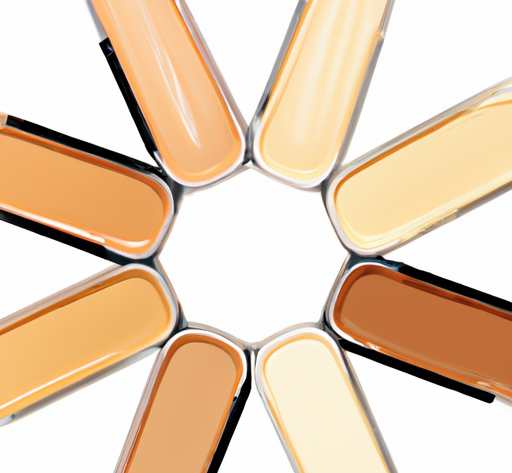Let’s face it, choosing the right foundation shade can sometimes feel like a daunting task. With the vast array of options available, it’s easy to get overwhelmed and end up with a shade that doesn’t quite match your skin tone. But fear not, because in this article, we will guide you through the process of selecting the perfect foundation shade that will beautifully enhance your natural complexion. From understanding your undertones to testing the shades on your jawline, we’ve got you covered. So sit back, relax, and get ready to find your perfect match!
Understanding your skin undertone
Identify your skin undertone
Understanding your skin undertone is crucial when it comes to choosing the right foundation shade. Your skin undertone is the underlying tone beneath the surface of your skin, and it plays a key role in determining which shades of foundation will best complement your complexion. There are three main undertones: cool, warm, and neutral.
Cool undertones
If you have cool undertones, your skin will have a slight pink, red, or blue hue to it. You may also notice that your veins appear more blue than green. People with cool undertones tend to look best in foundations with cool or neutral undertones. These shades typically have a slightly pink, rose, or blue base, which helps balance and enhance cool undertones.
Warm undertones
On the other hand, warm undertones are characterized by a golden, peachy, or yellowish hue to the skin. Veins may appear more green than blue. If you have warm undertones, foundations with warm or neutral undertones work best for you. These shades often have a yellow or golden base, which complements and enhances warm undertones.
Neutral undertones
Neutral undertones are a blend of both cool and warm undertones. If you have a neutral undertone, your skin may appear neither too pink nor too yellow, and your veins may appear more blue-green or neutral. People with neutral undertones have the advantage of being able to wear foundations with both cool and warm undertones, as well as neutral undertones. This versatility allows for a wider range of shade options.
Determining your skin tone
Consider your skin complexion
Determining your skin tone goes beyond just identifying your undertone. You also need to consider your overall complexion. Fair, light, medium, tan, or deep are common descriptors for skin tones. Understanding your skin complexion will help you choose the appropriate depth of foundation shade.
Observe your natural hair color
The color of your hair can also provide valuable insights into your skin tone. If you have warm undertones, you might have hair that is golden blonde, auburn, or strawberry blonde. Cool undertones are often associated with ash brown, black, or platinum blonde hair. If your hair is a neutral brown or a mix of warm and cool tones, you likely have a neutral undertone.
Examine your eye color
Eye color can also give clues about your skin tone. Warm undertones are often accompanied by amber, hazel, or brown eyes. Cool undertones are commonly seen in people with blue, gray, or green eyes. Neutral undertones can have a wide range of eye colors, making it a bit more challenging to determine undertones from this factor alone.
Understanding foundation undertones
Identify foundation undertones
Just as you identify your own skin undertone, it’s crucial to understand foundation undertones as well. Foundations come in various undertones – cool, warm, and neutral – to match different skin tones. By selecting a foundation with a matching undertone to your own, you’ll achieve a more natural and seamless finish.
Cool undertones
Foundations with cool undertones typically have a pink or blue base. They work well for people with cool undertones, as they counteract any redness and provide a balanced, natural look. Look for foundation shades labeled with terms like “cool,” “rosy,” or “porcelain” for the perfect match.
Warm undertones
For those with warm undertones, foundations with warm undertones are the way to go. These foundations typically have a yellow or gold base, which helps enhance and complement warm undertones. Look for shades labeled with terms like “warm,” “golden,” or “beige” for the best results.
Neutral undertones
If you have neutral undertones, consider yourself lucky! You can choose foundation shades with either warm or cool undertones, as well as those labeled as neutral. This flexibility gives you a wider range of options, so feel free to experiment and find the shade that suits you best.
Testing foundation shades
Visit a makeup counter or beauty store
When it comes to choosing the right foundation shade, it’s essential to test the shades in person. Visiting a makeup counter or beauty store allows you to swatch and compare different shades directly on your skin. The expert staff can also assist you in finding the perfect match based on your undertone and skin tone.
Test foundations on your jawline
A common mistake when testing foundation shades is applying them on the back of the hand. The skin on your hands may differ from that on your face, leading to an inaccurate match. Instead, apply small swatches of different foundation shades along your jawline. This area is closer in tone to your face and can give a more accurate representation of how the shade will look on your skin.
Consider natural lighting
Natural lighting is crucial when testing foundation shades. The harsh fluorescent lighting in stores can distort colors, so step outside or near a window to observe how the shade looks in natural light. Take note of how the foundation appears under different lighting conditions to ensure a seamless match.
Observe how the shade blends with your skin
Once you’ve applied different foundation shades along your jawline, observe how each shade blends with your skin. The right shade should seamlessly blend into your natural complexion without leaving any noticeable lines or demarcations. Pay attention to how the foundation looks after a few minutes, as some foundations may oxidize and darken or change throughout the day.
Consulting with professionals
Seek advice from makeup artists
If you’re still unsure about choosing the right foundation shade, seek advice from professional makeup artists. Makeup artists have extensive knowledge and experience in matching foundation shades to different skin tones and undertones. They can provide personalized recommendations and even demonstrate how to apply the foundation for a flawless finish.
Visit dermatologists or aestheticians
Dermatologists and aestheticians are skincare experts who can also guide you in choosing the right foundation shade. They can assess your skin type, undertone, and any specific concerns you may have. Additionally, they can recommend foundation formulas that are suitable for your skin, ensuring that your makeup not only looks good but also helps maintain the health of your skin.
Considering coverage and finish
Choose the right foundation coverage
Aside from finding the perfect shade, it’s important to consider the coverage you desire. Foundations come in different coverage levels, ranging from sheer to full coverage. Sheer foundations provide a lightweight, natural look and are great for evening out the skin tone. Medium coverage foundations offer more coverage without feeling heavy, while full coverage foundations effectively conceal blemishes, redness, or discoloration.
Explore different finishes
Foundation finishes determine the overall look and feel of your makeup. Common finishes include matte, dewy, satin, and radiant. Matte finishes are suitable for those with oily skin or those who prefer a more matte, shine-free look. Dewy finishes, on the other hand, provide a natural, luminous glow and work well for dry or dull complexions. Satin and radiant finishes offer a balanced, semi-matte look that suits most skin types.
Matching foundation shades
Use shade matching tools
Many brands provide shade matching tools to help you find your perfect foundation shade. These tools can be in the form of online quizzes, shade finders on websites, or even physical swatch cards. By inputting information about your skin tone, undertone, and other factors, these tools can suggest foundation shades that are likely to be a good match.
Compare foundation shades on your skin
When in doubt, it’s always helpful to compare foundation shades directly on your skin. Apply small swatches of multiple shades to different parts of your face, such as your cheek or forehead. This allows you to see how each shade blends with your skin and how it looks in different areas. Be sure to check in different lighting conditions to ensure the shade consistently matches your skin tone.
Adapting foundation shades for seasonal changes
Transitioning from winter to summer
As the seasons change, so can your skin tone. For instance, during the winter months, your skin may be paler, while it may deepen with a sun-kissed glow in the summer. To adapt to these seasonal changes, consider having two shades of foundation – one lighter for the colder months and a slightly darker shade for when your skin tans during summer. This way, you can mix the shades as needed to match your evolving skin tone.
Adjusting for changes in skin tone
Aside from seasonal changes, factors such as vacations, use of self-tanners, or hormonal fluctuations can also alter your skin tone. If you notice your skin tone changing, don’t be afraid to reassess your foundation shade and make adjustments accordingly. Your foundation should always complement your current skin tone for a natural, flawless finish.
Understanding common foundation shade mistakes
Avoiding shades that are too light or dark
One of the most common mistakes people make when choosing foundation is selecting shades that are either too light or too dark for their skin tone. A shade that is too light can leave a ghostly appearance, while a shade that is too dark can create an unnatural contrast or even make you look older. Always aim to find a foundation shade that seamlessly blends with your natural skin tone.
Wrong undertone
Another common mistake is choosing a foundation with the wrong undertone. If your foundation has a different undertone than your natural skin, it can clash and create an unbalanced or unnatural appearance. Always remember to consider your undertone when selecting foundation shades, as this will ensure the most harmonious and flattering result.
Inconsistent shade blending
Even with the right shade, improper blending can hinder achieving a flawless finish. It’s crucial to blend the foundation well into your skin, ensuring that there are no visible streaks or lines. Take the time to blend the foundation evenly using brushes, sponges, or your fingertips, paying attention to areas like the jawline and hairline.
Experimenting and finding the perfect match
Try samples
If you’re hesitant to commit to a full-size foundation, try asking for samples at makeup counters or beauty stores. Most brands are happy to provide samples, allowing you to test the foundation shade and formula for a few days before making a purchase. This way, you can see how the foundation wears throughout the day and under different conditions.
Mixing foundations
If you can’t find the exact foundation shade that matches your complexion, don’t fret! You can always experiment with mixing different foundation shades together to create a customized match. Mixing foundations not only allows you to adjust the shade but also helps tailor the formula to meet your specific preferences, such as blending different coverage levels or finishes.
Choosing the right foundation shade may take some time and experimentation, but it’s a vital step in creating a flawless makeup look. Remember to consider your undertone, skin tone, and other factors like coverage and finish. By understanding your skin undertone, consulting with professionals, and testing foundation shades, you’ll be well on your way to finding your perfect match. So go ahead, embrace your unique beauty and enjoy the confidence that comes with a foundation shade that enhances your natural radiance.




